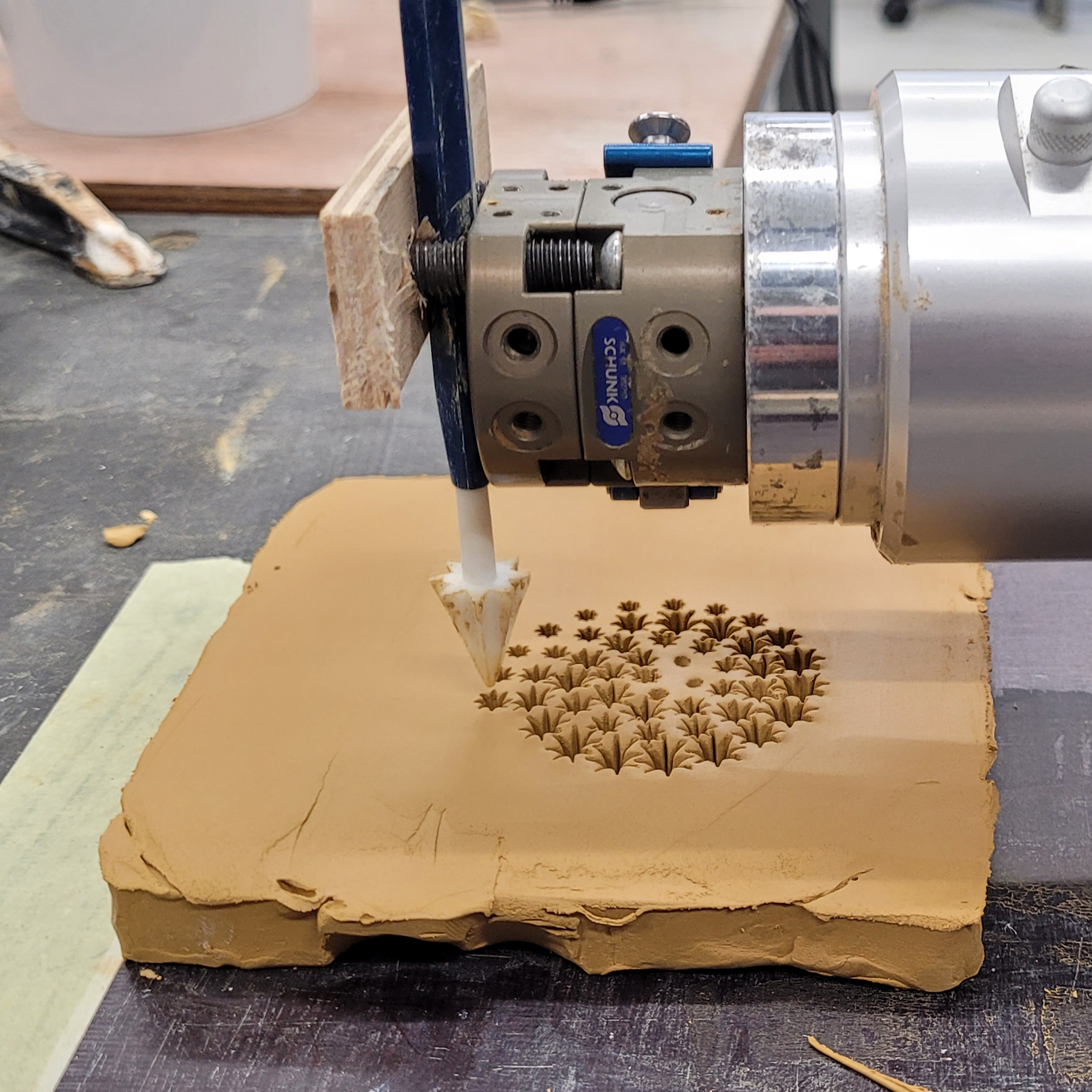Human–Material Dialogues Through the Use of Robotics
Embodied Craft Learning in an Architectural Educational Context Exploring Patterns in Clay
DOI:
https://doi.org/10.7577/formakademisk.5442Emneord (Nøkkelord):
Robotics, Craft, embodied learning, Human-material dialogue, ceramicsSammendrag
This research investigates and discusses an embodied craft learning situation in an educational context that aims to support students within architecture by applying human–material dialogues when using robotics. Initially, the students were introduced to traditional craftsmanship based on materials and tools in ceramics. Based on the gained experiential knowledge, the same tools and materials were applied and explored on a UR 5 robot. A sensor provided the students with the opportunity to interact with the material through the robot while it was operating. The learning situation showed the potential to teach the students about robotics based on human–material dialogues and embodiment through making. The sensor enabled the students to use their experiential knowledge to improvise and work intuitively and spontaneously while they were exploring patterning based on the tools attached to the robot and the responsive material.
Referanser
Binder, T., & Redström, J. (2006). Exemplary design research. In K. Friedman, T. Love, E. Côrte-Real, & C. Rust (Eds.), Wonderground – DRS International Conference (pp. 1–4). https://dl.designresearchsociety.org/drs-conference-papers/drs2006/researchpapers/51
Brinck, I., & Reddy, V. (2020). Dialogue in the making: Emotional engagement with materials. Phenomenology and the Cognitive Sciences, 19(1), 23–45. https://doi.org/10.1007/s11097-019-09629-2
DeLanda, M. (2004). Material complexity. In N. Leach, D. Turnbull, & C. Williams (Eds.), Digital techtonics (1st ed., pp. 14–21). Academy Press.
Dormer, P. (1994). The art of the maker. Thames and Hudson.
Downton, P. (2003). Design research. RMIT Press.
Dufva, T. S. (2018). Art education in the post-digital era - Experiential construction of knowledge through creative coding. https://doi.org/10.13140/RG.2.2.10040.85765
Falin, P., Horsanali, N., Hansen, F. T., & Mäkelä, M. (2021). Practitioners’ experience in clay 3D printing: Metaphorical viewing for gaining embodied understanding. FormAkademisk, 14(2), Article 2. https://doi.org/10.7577/formakademisk.4200
Johns, R. L., Kilian, A., & Foley, N. (2014). Design approaches through augmented materiality and embodied computation. In W. McGee & M. Ponce De Leon (Eds.), Robotic fabrication in architecture, art and design (pp. 319–332). Springer International Publishing. https://doi.org/10.1007/978-3-319-04663-1_22
Keep, J. (2019). Potting in a digital age. Studio Potter, 47(1). https://studiopotter.org/potting-digital-age
Koskinen, I., Binder, T., & Redström, J. (2008). Lab, field, gallery, and beyond. Artifact: Journal of Virtual Design - Artifact, 2, 46–57. https://doi.org/10.1080/17493460802303333
Leach, B. (1976). A potters book. Faber & Faber.
Ma, Z., Duenser, S., Schumacher, C., Rust, R., Bächer, M., Gramazio, F., Kohler, M., & Coros, S. (2020). RobotSculptor: Artist-directed robotic sculpting of clay. In Proceedings of the 5th Annual ACM Symposium on Computational Fabrication (pp. 1–12). https://doi.org/10.1145/3424630.3425415
McCullough, M. (1998). Abstracting craft. The practiced digital hand. MIT Press.
Pallasmaa, J. (2005). The eyes of the skin. Wiley-Academy.
Rheinberger, H.-J. (2012). Experimental systems: Difference, graphematicity, conjuncture. In F. Dombois, U. M. Bauer, C. Mareis, & M. Schwab (Eds.), Intellectual birdhouse: Artistic practice as research (pp. 89–99). König. https://hdl.handle.net/11858/00-001M-0000-002A-BC9D-9
Schön, D. (1983). The reflective practitioner. How professionals think in action. Temple Smith.
Sennett, R. (2008). The craftsman. Yale University Press.
Warnier, C., Verbruggen, D., Ehman, S., & Klanten, R. (2014). Printing things, visions and essentials for 3D printing. Gestalten.
Zoran, A., & Buechley, L. (2013). Hybrid reassemblage: An exploration of craft, digital fabrication and artifact uniqueness. Leonardo, 46, 4–10. https://doi.org/10.1162/LEON_a_00477

Nedlastinger
Publisert
Hvordan referere
Utgave
Seksjon
Lisens
Opphavsrett 2023 Flemming Tvede Hansen

Dette verket er lisensiert under Creative Commons Attribution-NoDerivatives 4.0 International License.
- Forfatteren(e) beholder sin opphavs- og kopieringsrett til eget manuskript, men gir tidsskriftet varig rett til 1) å fremføre manuskriptet for offentligheten i den opprinnelig publiserte digitale form, og 2) å registreres og siteres som første publisering av manuskriptet.
- Forfatteren må selv forvalte sine økonomiske kopieringsrettigheter overfor eventuell tredjepart.
- Tidsskriftet gir ingen økonomisk eller annen kompensasjon for innsendte bidrag, medmindre det er gjort særskilt avtale om dette med forfatteren(e).
- Tidsskriftet plikter å arkivere manuskriptet (inklusive metadata) i den opprinnelig publiserte digitale form, i minst ett dertil egnet åpent tilgjengelig langtidsarkiv for digitalt materiell, som for eksempel i de norske universitetenes institusjonsarkiv innen rammen av NORA-samarbeidet.
Verket vil bli publisert OpenAccess med en Creative Commons 4.0-lisens som tillater alle å lese, dele og tilpasse innholdet, også kommersielt, under lisensvilkårene:
Dette verket må tilskrives/ krediteres på riktig måte, en lenke må gis til CC-BY 4.0-lisensen, og endringer som er gjort må angis på en rimelig måte, men ikke på noen måte som antyder at lisensgiveren støtter deg eller din bruk.



